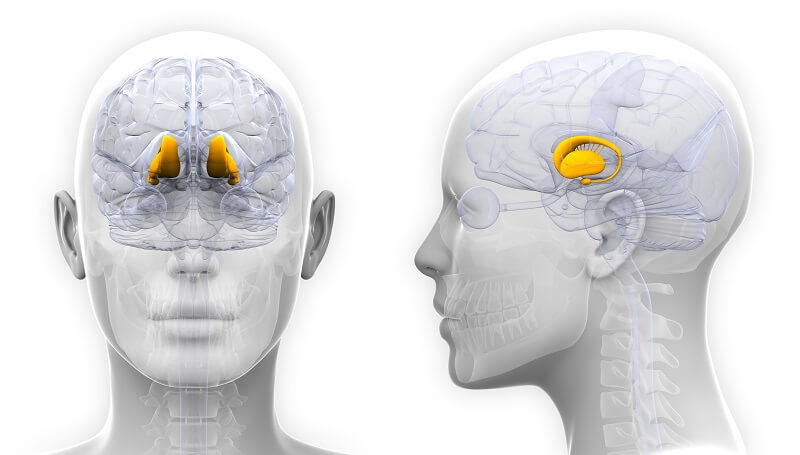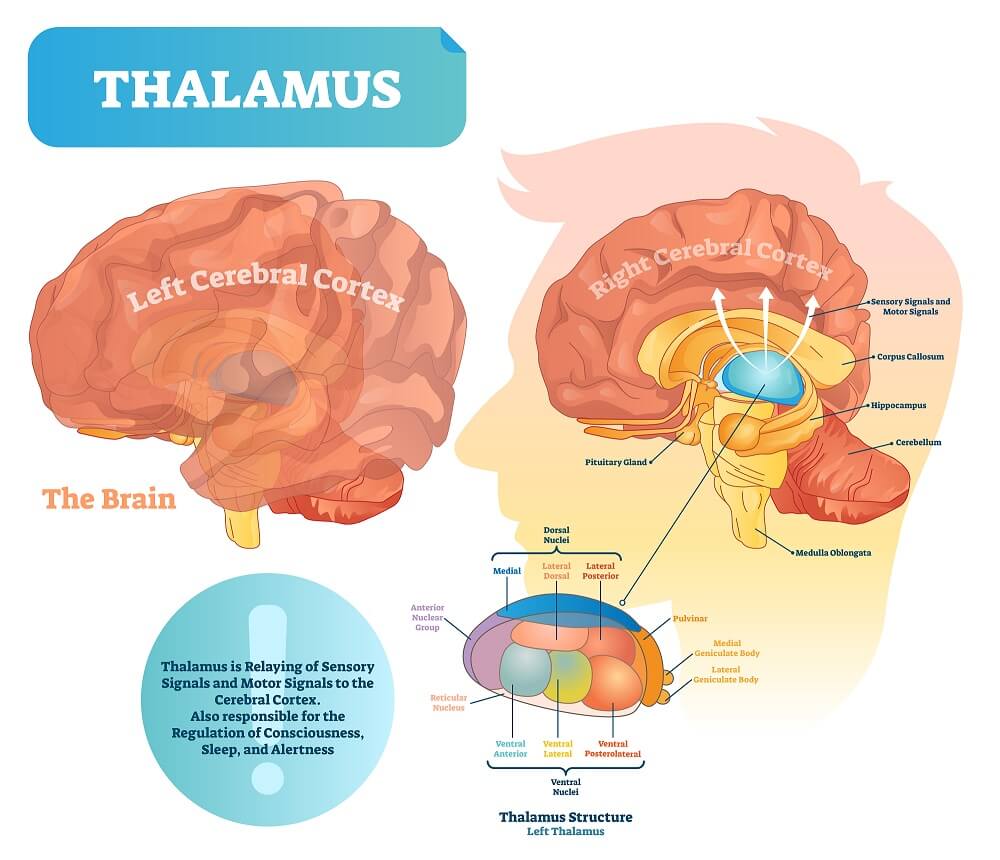Definition
The thalamus is a paired, symmetrical structure that is found at the base of the cerebrum, just above the brain stem. It acts as a relay station in the brain, regulating the flow of information from the spinal cord, brain stem, and other brain regions, to the appropriate location in the cortex.
The thalamus acts in concert with many regions of the brain. Therefore, it and has importance in various functions both in the central nervous system and the limbic system. For example, sensory perception, pain response, and emotional regulation.

Location of the Thalamus
The paired structure of the thalamus is located just above the brain stem in the cerebral hemisphere. It is found very centrally in the brain, with one part of the structure found in each brain hemisphere. It forms part of the diencephalon, which is a division of the forebrain.
Thalamus vs. Hypothalamus
Due to the similarity between their names, the thalamus and the hypothalamus are sometimes confused. However, they are very different structures, and the only reason they have such similar names is because of their location. The hypothalamus is found immediately below the thalamus (hypo- means ‘under’ in Ancient Greek).
The hypothalamus regulates homeostasis throughout the body through its close connection to the pituitary gland. This is distinct from the role of the thalamus, which relays sensory information to the appropriate part of the brain.
Anatomy of the Thalamus
The thalamus is a bilateral, symmetrical structure. Each of its two components is shaped like an American football. The thalamus is made up of various structures called nuclei, which each contain projections into different parts of the brain.
These nuclei all receive and transmit a different type of information. The nuclei are made up of neurons, mostly thalamic relay neurons. There are up to 60 different nuclei that have been identified in the thalamus. These nuclei can be grouped based on their location: anterior, medial, or lateral. Their functions are discussed in more detail below.

Function of the Thalamus
The thalamus is often described as a relay station because it is an important transfer hub of information. It is mostly considered part of the central nervous system, where is processes sensory and movement information and passes this on to the relevant areas of the brain.
However, it is also an essential part of the limbic system, which is involved in processing emotion, pain response, and higher cognitive functions. The thalamus is also thought to contribute to our consciousness and alertness, as well as controlling the sleep-wake cycle.
Different nuclei within the thalamus are important for passing on different types of information to the appropriate targets in the brain. The thalamic relay neurons that make up each nucleus are excitatory neurons that receive signals from a variety of areas of the brain. They then pass this information on to the appropriate location of the cortex.
Some notable examples of these nuclei and their functions are discussed below.
Anterior Nuclei
The anterior nuclei are a collection of nuclei found at the very back of the thalamus. These nuclei associate with the hippocampus and represent one of the regions of the thalamus that plays a role in regulating emotions. More specifically, the anterior nuclei play a key role in learning and episodic memory storage.
Dorsomedial Nucleus
The dorsomedial nucleus (or the medial dorsal nucleus) is a large nucleus of the thalamus. It is involved in emotional behavior and memory, including cognitive functions such as decision-making and reward-associations.
Ventral Anterior Nucleus
The ventral anterior (VA) nucleus is involved in motor functions. It receives signals from the basal ganglia, and its role is in the planning and initiation of movement.
Ventrolateral Nucleus
The ventrolateral nucleus (VL) is also involved in motor functions. In particular, it is involved in the coordination and planning of movement, as well as the learning of movement. Interestingly, lesions in this area of the brain have been associated with synesthesia, the strange perception phenomenon where individuals associate one sensory input with a second. For example, ‘feeling’ music, perceiving numbers as specific colors, or ‘seeing’ sounds.

Ventral Posterolateral Nucleus
The ventral posterolateral nucleus (VPL) makes up part of the ventral posterior nucleus. It receives sensory information from the body and transfers it to the cortex of the brain. For example, it relays information about external environmental signals such as temperature, pain, itching, and touch.
Ventral Posteromedial Nucleus
The ventral posteromedial nucleus (VPM) is – like the VPL – also part of the ventral posterior nucleus. This nucleus is responsible for receiving sensory information from particular regions of the face and mouth. Thus, it is important in regulating taste.
Reticular Nucleus
The thalamic reticular nucleus forms a sheet that makes a capsule around the structure of the thalamus. This nucleus is made up of inhibitory interneurons, rather than relay neurons that make up most of the nuclei of the thalamus. These neurons do not project into the cortex but instead project into the other nuclei, modulating their activity.
Clinical Relevance
Although uncommon, dysfunction of the thalamus has been linked to a few rare disorders.
Thalamic Pain Syndrome
A rare syndrome associated with stroke is called thalamic pain syndrome, also called Dejerine–Roussy syndrome. This disease occurs after a thalamic stroke, a stroke that causes damage to the thalamus. It causes numbness and tingling of the affected side, which progresses to pain and burning sensations associated with hypersensitivity.
Fatal Familial Insomnia
Fatal familial insomnia (FFI) is a rare genetic disorder that causes neurodegeneration. It is a prion disease that results in the misfolding of a specific protein called the prion protein (PrP). This misfolding mostly affects the thalamus, causing the neurons within it to die.
FFI causes dementia, insomnia, anxiety, and rapid weight loss. Towards the end of the disease, individuals suffer from delirium, struggle to walk and talk, and lose the ability to sleep entirely. As yet, there is no treatment to prevent or slow the disease and no cure.
Korsakoff Syndrome
Korsakoff syndrome is a memory disorder that results from vitamin B1 (thiamine) deficiency, usually caused by chronic alcoholism. The resulting symptoms include amnesia, apathy, and confabulation (i.e., the patient appears to invent memories that did not occur).
Thiamine is essential for the normal functioning of the thalamus because of its requirement for the metabolic process of converting sugar to energy in the brain. Without it, the neurons do not produce enough energy and can die.
Obsessive-Compulsive Disorder
Obsessive-Compulsive Disorder has been linked with altered brain anatomy. Specifically, this mental health disorder has been associated with the presence of an enlarged thalamus. Interestingly, it has been suggested that cognitive behavioral therapy in these individuals can reduce the volume of the thalamus.
Quiz
